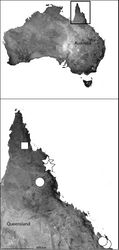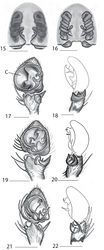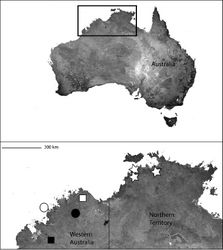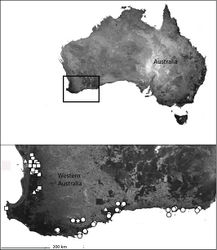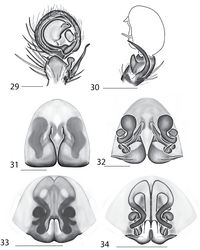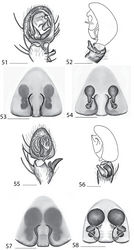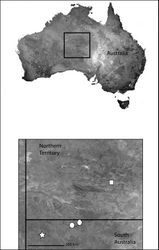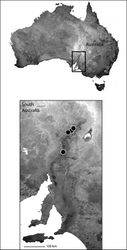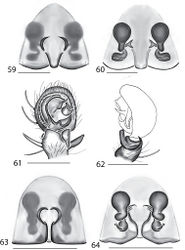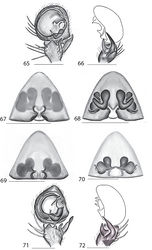Karaops
| Notice: | This page is derived from the original publication listed below, whose author(s) should always be credited. Further contributors may edit and improve the content of this page and, consequently, need to be credited as well (see page history). Any assessment of factual correctness requires a careful review of the original article as well as of subsequent contributions.
If you are uncertain whether your planned contribution is correct or not, we suggest that you use the associated discussion page instead of editing the page directly. This page should be cited as follows (rationale):
Citation formats to copy and paste
BibTeX: @article{Crews2011ZooKeys99, RIS/ Endnote: TY - JOUR Wikipedia/ Citizendium: <ref name="Crews2011ZooKeys99">{{Citation See also the citation download page at the journal. |
Ordo: Araneae
Familia: Selenopidae
Name
Karaops Crews & Harvey, 2011 gen. n. – Wikispecies link – ZooBank link – Pensoft Profile
- Selenops australiensis Koch 1875[1]: 615, plate 43, fig. 6. Koch 1876[2]: 832, plate 71, fig. 3.
Type species:
Karaops ellenae sp. n.
Etymology
Karaops gen. n. comes from a combination of words and honors the indigenous peoples of Australia by referring to the indigenous Selenopidae found throughout the continent. Nyoongar: [[Kara =|Kara =]] spider; Greek: ops = face, eye. We retain the traditional ending of selenopid genera of ops, which originally referred to the eye arrangement. The gender is masculine.
Diagnosis
Karaops gen. n. can be separated from all other genera by a combination of characters: 1. ventral tibial and metatarsal spination of legs I and II something other than 3–2, 2. absence of scopulae, 3. found only in Australia. The males have a small, simple MA that is not twisted in any species.
Description
Total length 3.90–10.30. Cephalothorax: Carapace with some dusky marks, usually wider than long. Fovea longitudinal, broad, and shallow. Setae variable, ranging from soft to thick and coarse, short peg-like spines to long and thin; some are of medium length and thickness. Chelicerae slightly geniculate, robust, with 3 prolateral and 2 retrolateral teeth, or 4 prolateral and 3 retrolateral teeth. Eyes: AER straight to slightly recurved to recurved, PER slightly recurved to strongly recurved. PME larger than AME in most species, though equal or smaller in some specimens. Legs: Leg III usually longest, though leg II or IV is longest in some species. Leg pattern 3241in most specimens, but is variable both between and within species, as in Selenops. Tibial and metatarsal ventral spination is primarily in pairs of 5 and 3, respectively, but can also be 6–3, 5–4, 6–4, 5–0, or are unpaired. Tarsal scopulae absent. Female copulatory organs: Epigynum with lateral lobes, a well-defined median area, and with or without epigynal pockets. Spermathecae and internal ducts range from simple and round to highly coiled. Male copulatory organs: Palpal tibia with 2 or 3 tibial apophyses. Dorsal apophysis longer than or equal to ventral apophysis in most species. MA 1 or 2 branched, ranging from unsclerotized to strongly sclerotized.
Remarks
Species ofKaraops gen. n. can be locally abundant, but are relatively rare or at least elusive given the low numbers of species in museum collections.Although none have yet been determined to be short range endemics (SREs) (Harvey 2002[3]), it is possible that with more thorough collecting in particular areas or with additional morphometric or molecular data, some will be found to be SREs. Many species are known only from one sex, and several species are known from only a single specimen.
Distribution
Karaops gen. n. occurs throughout mainland Australia, but is apparently absent from Tasmania (Maps 4–10).
Composition
In addition to transferring Selenops australiensis to Karaops gen. n., we describe 23 new species. It is likely that more species will be found. Given the large ranges of some species, yet seemingly stable morphology across isolated populations, molecular or morphometric data may reveal cryptic species.
Key to Karaops species
(males of Karaops monteithi sp. n., Karaops marrayagong sp. n., Karaops badgeradda sp. n., Karaops julianneae sp. n., Karaops martamarta sp. n., Karaops deserticola sp. n., Karaops jenniferae sp. n., Karaops dawara sp. n. unknown; females of Karaops alanlongbottomi sp. n., Karaops keithlongbottomi sp. n., and Karaops larryoo sp. n. unknown)
Original Description
- Crews, S; Harvey, M; 2011: The spider family Selenopidae (Arachnida, Araneae) in Australasia and the Oriental Region ZooKeys, 99: 1-104. doi
Other References
- ↑ Koch L (1875) Die Arachniden Australiens. Bauer and Raspe, Nürnberg 1:577-740.
- ↑ Koch L (1876) Die Arachniden Australiens. Bauer and Raspe, Nürnberg, 1:741-888.
- ↑ Harvey M (2002) Short-range endemism in the Australian fauna: some examples from non-marine environments. Invertebrate Systematics 16:555-570. doi: 10.1071/IS02009
Images
|

